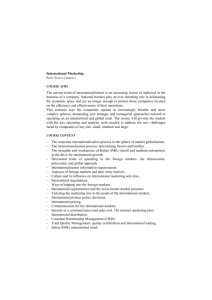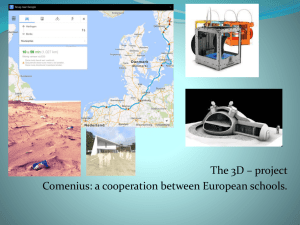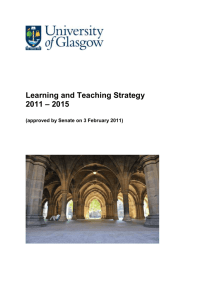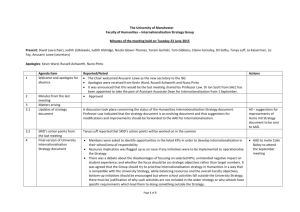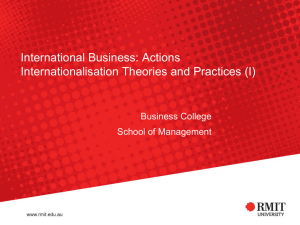Discussion 1. Catherine Mann
advertisement
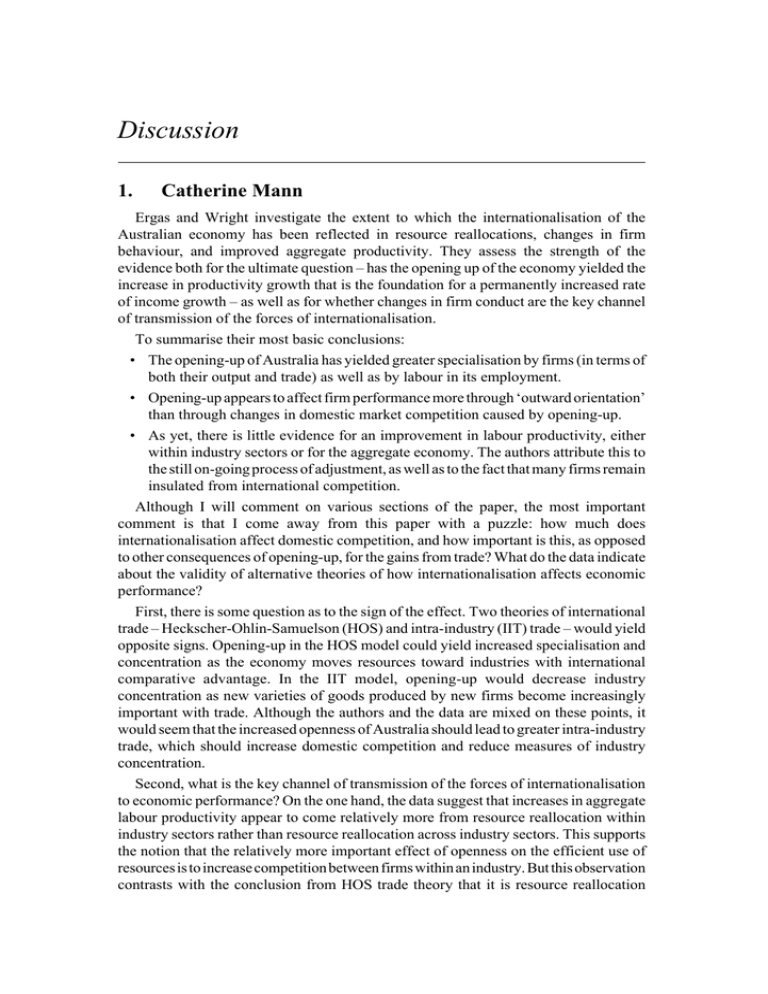
106 Discussion Discussion 1. Catherine Mann Ergas and Wright investigate the extent to which the internationalisation of the Australian economy has been reflected in resource reallocations, changes in firm behaviour, and improved aggregate productivity. They assess the strength of the evidence both for the ultimate question – has the opening up of the economy yielded the increase in productivity growth that is the foundation for a permanently increased rate of income growth – as well as for whether changes in firm conduct are the key channel of transmission of the forces of internationalisation. To summarise their most basic conclusions: • The opening-up of Australia has yielded greater specialisation by firms (in terms of both their output and trade) as well as by labour in its employment. • Opening-up appears to affect firm performance more through ‘outward orientation’ than through changes in domestic market competition caused by opening-up. • As yet, there is little evidence for an improvement in labour productivity, either within industry sectors or for the aggregate economy. The authors attribute this to the still on-going process of adjustment, as well as to the fact that many firms remain insulated from international competition. Although I will comment on various sections of the paper, the most important comment is that I come away from this paper with a puzzle: how much does internationalisation affect domestic competition, and how important is this, as opposed to other consequences of opening-up, for the gains from trade? What do the data indicate about the validity of alternative theories of how internationalisation affects economic performance? First, there is some question as to the sign of the effect. Two theories of international trade – Heckscher-Ohlin-Samuelson (HOS) and intra-industry (IIT) trade – would yield opposite signs. Opening-up in the HOS model could yield increased specialisation and concentration as the economy moves resources toward industries with international comparative advantage. In the IIT model, opening-up would decrease industry concentration as new varieties of goods produced by new firms become increasingly important with trade. Although the authors and the data are mixed on these points, it would seem that the increased openness of Australia should lead to greater intra-industry trade, which should increase domestic competition and reduce measures of industry concentration. Second, what is the key channel of transmission of the forces of internationalisation to economic performance? On the one hand, the data suggest that increases in aggregate labour productivity appear to come relatively more from resource reallocation within industry sectors rather than resource reallocation across industry sectors. This supports the notion that the relatively more important effect of openness on the efficient use of resources is to increase competition between firms within an industry. But this observation contrasts with the conclusion from HOS trade theory that it is resource reallocation Internationalisation, Firm Conduct and Productivity 107 across industry groups (from those with a comparative disadvantage to those with a comparative advantage) that is the principal source of the gains from opening-up. As a third possibility, the survey indicates that it is not domestic competition, but outward orientation that yields the greatest improvements in firm performance. Why should the external market be more demanding of firms than the internal market? Does this suggest that domestic firms find it more difficult to enter a new domestic market than a new international market? This paper makes an important contribution to our understanding of how internationalisation affects firm performance and productivity. However, there are several channels of transmission that the authors do not address. Specifically, they present no evidence on how internationalisation affects prices (although they do consider how opening-up affects costs), and from there on to affect firm performance and productivity. Thus, the relative importance of the various channels through which internationalisation affects performance and productivity remains unclear. The first half of the paper tries to establish both where Australia is now and where it is likely to go as the process of internationalisation matures. First, the authors measure how much Australia has opened up using measures of trade intensity and FDI linkages. They also rank Australia against selected other OECD countries as comparators for what we might expect as internationalisation proceeds. Second, they analyse measures of inter and intra-sectoral resource reallocations using concentration, trade specialisation, and structural adjustment indices and consider to what extent we might have expected the observed results from the process of opening-up. I have some reservations about the comparator countries as an indication of what we might expect of Australia in the future. It seems quite difficult to find a good comparator country for Australia. The individual European countries are not appropriate because of their different resource endowments, as well as the key issue of proximity. An alternative approach would be to use the European Union as a single unit in the ranking, and judge the openness of Australia relative to the US, Canada, Japan and the EU. As a rationale for this approach, recall that soon trade data will only be available for trade between the EU and the world, but not for intra-EU member trade. A key observation is that Australia differs from the other countries not so much in the level of trade intensity but in how little trade intensity has changed over the decades, and also how it fell and then rose more recently after the reforms. Trade intensity has increased markedly and uniformly for the other countries shown. Any apparent delay in Australia’s response to opening-up may be a result of having to catch-up with the other countries. An alternative modelling strategy might focus on changes in openness, instead of levels of openness. Second, the underlying premiss on how some of the measures of resource reallocation should change with greater openness could be questioned. The authors suggest that greater openness and associated resource reallocation toward sectors with comparative advantage should lead to increased Herfindahl indexes of domestic competition. They show that these indices have increased a bit, but remain below levels of some European countries. Besides the issue of the comparator, noted above, another issue emerges. As the authors note, one outcome of internationalisation is increased intra-industry trade. (There is some evidence of increased IIT for Australia, although it is hard to see in the 108 Discussion figure.) But, openness and increasing IIT may imply increasing numbers of firms that produce for specific market niches at home and abroad, which would probably reduce the Herfindahl indices. Moreover, an important issue for both the Herfindahl and IIT indices is the aggregation bias. A very important observation is that increases in aggregate manufacturing labour productivity growth appear to have come mostly from changes in labour productivity within an industry group, rather than from shifting labour across industry groups. This is not what we would expect if the fundamental outcome of opening the Australian economy was to shift resources toward sectors with a comparative advantage and away from sectors with a comparative disadvantage. However, the data do make sense if Australia’s resources already were concentrated in the sectors of comparative advantage, but with insufficient domestic and foreign competition to encourage efficient production. Based on this observation, it appears that the most important channel through which openness can affect economic performance is increased domestic and foreign competition within a sector. In this regard, it is unfortunate that the authors do not examine price data to see what it might imply for competition. The second part of the paper utilises a new survey dataset that focuses on the role of international competition in affecting firm performance. The survey creates a very extensive dataset on manufacturing strategy, management methods, and firm performance, with an explicit focus on the international environment. There are quite a few generalisations offered in this section based on the survey responses, and in some cases, based on regression analysis of these data. Some of the regressions investigate various hypotheses about how openness might affect firm performance, e.g. quality of product, relative unit costs, and exports. The presentation of the results might be enhanced if the survey analysis and regressions were more closely tied to a concrete and central hypothesis, say how internationalisation affects the ‘structure, conduct, performance’ paradigm used in industrial organisation studies. Moreover, the regressions seem somewhat disjointed, in that in any given regression, the authors appear to have chosen a subset of the available variables for inclusion without really explaining their variable choices. Since this part of the paper represents a first effort in assessing a new dataset, it is not surprising that the analysis is far-ranging and the data somewhat overwhelming. One of the stronger conclusions is that firms with an outward orientation perform better. Unfortunately, the survey provides little information on the degree of domestic or import competition faced by the firms, although the authors do attempt to remedy this gap by constructing several measures of import competition. Thus, it is hard to judge whether it is international competition more generally that spurs improved performance, or an explicitly outward orientation. While recognising the risks of suggesting that the authors add more to this section, an important question in many countries is how small and medium-sized enterprises perform, as compared with large firms. Since the survey provides several measures of size (sales, employees) an analysis of systematic differences across firm size would be possible. Internationalisation, Firm Conduct and Productivity 2. 109 General Discussion The discussion was wide ranging, but was dominated by four issues: • the usefulness of the survey for analysing questions regarding internationalisation; • the links between trade orientation and firm behaviour; • the impact of greater openness on the services and non-traded sectors; and • the implications of exchange rate volatility. The general tone of the discussion was that research using firm-level data was extremely valuable. Perhaps the most important gains from trade were not from a reallocation of resources between industries (as traditional theory suggests), but rather from an improvement in the use of resources within industries. If this is correct, then studies examining the links between international trade and firm behaviour were vitally important in establishing and quantifying the benefits of trade reform. A number of issues were raised concerning the interpretation of the survey and its results. Some participants wondered whether the results could be generalised to industries other than manufacturing, and asked how the degree of competition in a market should be measured. Others wondered about the direction of causation – are firms that have relatively large research and development programs more likely to export, or do firms that export have a greater incentive to do research and development? Most thought that causation ran in both directions. One participant suggested that the conclusions about the links between exporting and firm behaviour would be stronger if time-series, rather than cross-section, data were used. Finally, one participant was quite hostile to the survey, and the use to which it had been put in the paper. It was argued that the survey and paper did not address the really important issues, namely the excessive capital-labour ratio and low capacity utilisation in Australian manufacturing. In terms of the links between labour productivity and trade reform, a number of participants asked whether the ‘stick’ of increased imports, or the ‘carrot’ of increased exports, was more important in generating increases in productivity. Results of work, both in Australia and in Korea, were reported which suggested that those industries that were subject to the largest reductions in protection, experienced the largest increases in trade intensity and the largest gains in efficiency. One participant picked up the statement in the paper that 30 years of research on school performance highlighted the importance of leadership. It was suggested that the same is true for firm performance. By increasing the return to good leadership, and the penalty for poor leadership, trade liberalisation should lead to better management in manufacturing firms. It was felt that the results presented in the paper represented some weak evidence in support of this idea. In discussing the wider implications of internationalisation on labour productivity, there was some discussion of the non-traded sector. The point was made that trade liberalisation changed the political environment to one that was more conducive to reform of the traditionally non-traded sectors of the economy. This happens in a number of ways. First, trade reform is predicated on the notion that competition is ‘good’. Once this notion is accepted, it seems inappropriate to stop the idea being applied to other parts of the economy. Second, as international trade becomes more important, ‘competitiveness’ issues loom larger in the national mind-set. This helps focus attention on reform in 110 Discussion industries producing intermediate inputs into the production of final goods. Third, once a free trade environment is adopted, policy makers can give more attention to policy reform in non-traded sectors of the economy. A number of participants argued that these ‘spillover’ pressures on the non-traded part of the economy represented a significant benefit of trade liberalisation. On the issue of exchange rate volatility, there was some discussion of the statement in the conclusion of the paper that manufacturers found exchange rate variability to be a major obstacle to exporting. There was little doubt that despite a variety of hedging techniques, exporters and importers of manufacturers found exchange rate variability an impediment to trade. On the other hand, movements in the exchange rate help insulate the domestic economy from a variety of shocks, including terms of trade changes. If changes in the exchange rate did not occur, it is likely that the economy would experience larger swings in domestic output and inflation. It is far from clear that these movements would be less costly to exporters and importers than the swings in the exchange rate that they currently experience.
